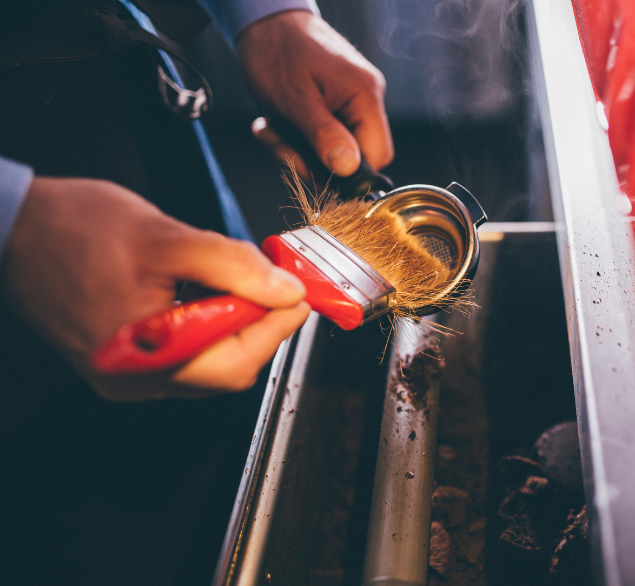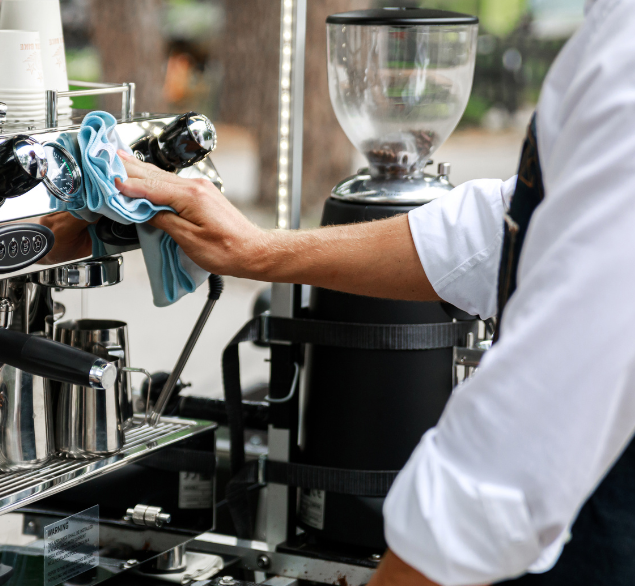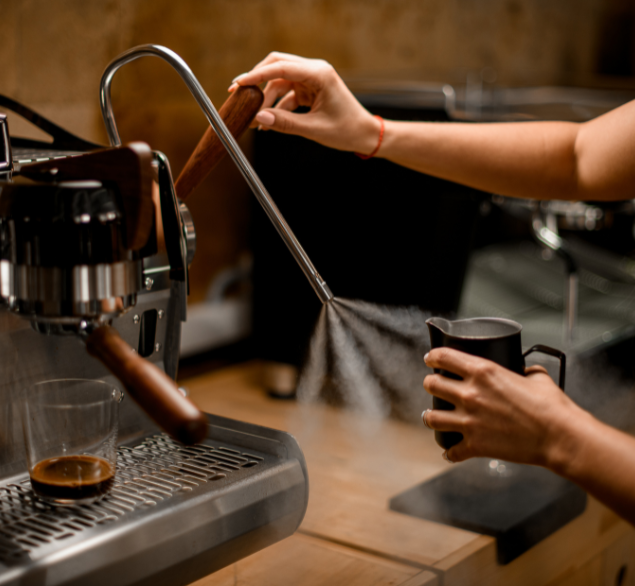How to Clean Your Espresso Machine
A clean coffee machine is more than just hygienic, it's also a way to reduce maintenance costs and ensure your coffee tastes better for longer.
In this guide we’ll look at the importance of a clean espresso machine and some tips on how to clean a coffee machine to get the best quality out of your espresso machine every time.
Why is it important to clean your espresso machine?
To know how to clean a coffee machine, it’s good to know why it is important to clean espresso machines in the first place.Over time, accumulated residues like milk, coffee and limescale from the water supply can build up on the inside and outside of your coffee machine, leaving it looking unclean to customers and negatively affecting the taste of the coffee it produces.
In severe cases, this can shorten the lifespan of your commercial coffee machine significantly, as well as causing unexpected outages that hurt your profits in both lost business and engineer call-out fees.

Common risks from unclean espresso machines
There’s a surprisingly long list of negative effects from an unclean espresso machine, but some of the most common outcomes include:
Burnt and bitter coffee
Remnants of burnt-out coffee grounds can get into later cups, giving your espresso a sour, bitter or burnt flavour, which can be off-putting to customers and is a sure sign of an unhygienic coffee machine cleaning regime.
Uneven operation
Dirt and dried-on coffee oils can clog the holes in your espresso machine, leading to uneven extraction and unreliable operation. Those oils can also find their way into subsequent cups, adding to the unwelcome bitter taste.
Serious health risks
In the most extreme cases, bacteria like Pseudomonas can develop inside your coffee machine. Without proper cleaning, this can cause serious lung infections and poses a particularly high risk to immunocompromised individuals.
How to clean a coffee machine
You should carry out a comprehensive cleaning checklist at the end of every day to make sure you remove residues before they have a chance to dry or cake on to your machine.
Make cleaning steam wands an every-use task, by giving the wand a wipe down with a damp cloth that is not used for anything else.
It’s a good idea to descale espresso machine parts periodically, especially if your business is in a hard water area. The best kind of coffee and espresso machine descaler will depend on your equipment – cleaning procedures are different for espresso machines than for bean-to-cup coffee machines, for example.
Always check the manufacturer’s instructions and only use cleaning products that are recommended, such as commercial food-safe detergents and soft, clean cloths that will not damage your coffee machine.

Daily tasks
Remember that cleaning steam wand residue should be an every-time commitment. Replace the cloth you use for this frequently, and don’t use the same cloth for anything else, like wiping down your bar or counter.
At the end of every day, disinfect the steam wand. Do not submerge the wand in water, as this can result in the milk being sucked into the boiler, with serious potential consequences for your coffee machine.
In addition to wiping the steam wand on each use, performing a quick “purge” by turning on the steam for a second will release condensation and milk residue. This is important to prevent clumps of milk building up inside the boiler which will invalidate the warranty and can be difficult to remove.
Clean coffee machine group heads when you get a quiet period. You can do this by flushing them with fresh water and then removing any remaining coffee residue using a dedicated group head cleaning brush.
Top tips for daily coffee machine cleaning
One top tip for how to clean a coffee machine more effectively is to focus on any areas around the seal, where accumulated coffee remnants can damage the rubber and lead to leakage.
Know how to clean coffee and espresso machines inside and out. Backflush with plain water during the day and with detergent at the end of the shift, especially if you use your coffee machine frequently every day.
A clean espresso machine needs to be cleaned on the exterior too, so use a suitable antibacterial detergent to reduce risks like Pseudomonas.
Finally, make it a routine task to empty your drip trays and waste containers regularly (or, during busy periods, when needed) and be sure to actually clean them – don’t just empty them and put them back unwashed.
Weekly tasks
Weekly cleaning tasks should be more detailed and in-depth, focusing on the parts of your coffee machine that see regular use, but which are not comprehensively cleaned on a daily basis.
Some examples of this include:
- Remove portafilters and baskets and soak in hot water and cleaning powder
- Remove shower plates carefully and clean with a soft cloth and hot water
- Inspect the steam wand and remove any blockages from individual holes
- Clean group heads and handles with a back-flush detergent
- Remove coffee grease and oils with a cleaning brush and rinse thoroughly
You should clean the exterior of your coffee machine regularly anyway, but give extra attention to the top surface and sanitise it thoroughly, so that you can store cups safely on top of your machine.

When to descale espresso machines
Limescale build-up is a concern depending on the hardness of your mains water supply, and you may want to consider a pre-filter to reduce scaling in your coffee machine.
It’s likely that your commercial coffee machine has a dedicated descaling program, as well as manufacturer-recommended coffee machine descaler products.
As a general rule of thumb, you should descale espresso machines at least monthly. However, if you are unable to use filtered ‘softened’ water, it’s sensible to descale more frequently to prevent accumulation over the medium term.
Annual tasks
No matter how carefully you look after your coffee machine, there’ll always be parts you can’t reach. Our full servicing of your espresso machine involves stripping it down, cleaning it thoroughly inside and out, and then reassembling it correctly.
An annual PSSR coffee machine test is essential to check that your boiler is working correctly. Again, coffee machine pressure tests can be carried out as part of your annual service, or on-site at a time that suits you.
Your annual service is also an opportunity to get an independent opinion about the condition of your coffee machine, and to spot any excess wear and tear that has been caused by substance build-up or incorrect cleaning procedures.

What to use to clean your machines
It’s always best to clean espresso machines with the manufacturer’s recommended products, or a direct equivalent designed specifically for the task.
Only apply cleaning products using purpose-made brushes and dedicated soft clean cloths, which should be washed and replaced regularly. For any additional cleaning equipment you require, we stock a wide range of coffee machine cleaning products including brushes
Finally, resist internet ‘hacks’ like vinegar and baking soda. While these may be appropriate for occasional cleaning of domestic equipment, they’re not suitable for frequent commercial coffee machine cleaning, and may void your warranty.
Mulmar coffee machine maintenance
To find out more about our premium coffee machine maintenance services, contact Mulmar today and speak to one of our qualified coffee machine engineers, who can help provide a bespoke solution for your business.